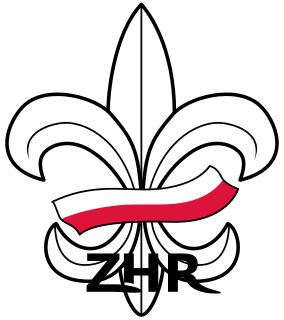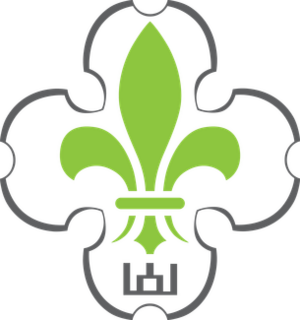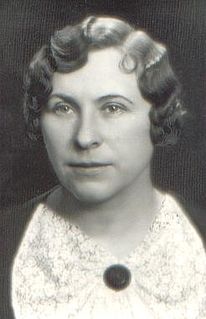Mindaugas Murza, officially changed his name to Mindaugas Gervaldas in 2012, is a Lithuanian radical nationalist and a Neo-Nazi. He was a member of the Lithuanian National Defence Volunteer Forces. He has been a member, founder, and chairman of several different Neo-Nazi political parties. Only one party, the National Democratic Party of Lithuania, was officially registered and participated in the 2003 municipal elections. Murza and three others were elected to the council of the Šiauliai City Municipality.

Związek Harcerstwa Rzeczypospolitej is a Polish Scouting organization founded on February 12, 1989. At present, Związek Harcerstwa Rzeczypospolitej has over 17,500 members. At present, Związek Harcerstwa Rzeczypospolitej is an associate member of the Confederation of European Scouts.

Latvijas Skautu un Gaidu Centrālā Organizācija is the primary national Scouting and Guiding organisation of Latvia and a member of both the World Association of Girl Guides and Girl Scouts and the World Organization of the Scout Movement. The organization had 759 members as of 2011. Scouting activities began in Latvia in 1917 when the area was still part of the Russian Empire. After independence in 1918, the national organization was established and Scouting thrived in Latvia in the 1920s-1930s. Upon the Soviet occupation of Latvia in 1940, Scouting was suppressed and not re-established until 1990, when Latvia regained its independence.

The Lithuanian Riflemen's Union, or LRU, also referred to as Šauliai, is a paramilitary non-profit organisation supported by the State. The activities are in three main areas: military training, sport, and culture.

Lietuvos skautija, the primary national Scouting organization of Lithuania, became a member of the World Organization of the Scout Movement in 1997. The coeducational Lietuvos skautija has 1,446 members as of 2012.

The Scout and Guide movement in Canada is served by many separate organizations, some with various national and international affiliations.

The Confederation of European Scouts, called in French Confédération Européenne de Scoutisme and abbreviated as CES, was formed in Brussels, Belgium, on 12 November 1978 and is still based in Belgium. CES stresses the European dimension of the Scouting programme and claims to provide the "authentic Scouting of Baden-Powell". The CES is a confederation of national federations. The CES is a split-off from the Fédération du Scoutisme Européen (FSE) later renamed to the Union Internationale des Guides et Scouts d'Europe; it left after controversies about the importance of religious elements in the single associations' programs and co-education. The exact number of members of the CES is unknown.
Lietuvos skaučių seserija is a Guiding association in Lithuania. Guiding in Lithuania started in 1926, was banned by the Soviets in 1940 and restarted in 1990.

The Scouting and Guiding movement in Poland consists of about twelve independent organizations with an overall membership of about 160,000 Scouts and Guides. The largest organization by membership is Polish Scouting and Guiding Association with about 140,000 members.
The Scout and Guide movement in Latvia is served by:
The Lithuanian National Prize, established in 1989, is an award granted for achievements in culture and the arts. It has been awarded annually in six categories since 2006. The prize is formally bestowed on February 16, when the decorations and diplomas are presented to the laureates at Presidential Palace, commemorating the anniversary of the 1918 Act of Independence of Lithuania.

Lietuvos skautų sąjunga is one of Lithuania's Scouting organizations. The organization serves about 1,300 members as of 2008.

The Lithuanian Confederation of Industrialists or LPK is a major association of industry associations and companies in Lithuania which represents the interests of large industrialists and employers. The Confederation in an umbrella organization uniting 52 trade and 5 regional associations and 24 non-associated members which comprise over 2700 medium and large enterprises from various public and private sectors. Confederation membership is entirely voluntary. LPK members cover all the main sectors of industry and unite over a third of the Lithuanian work force, which generates almost 83% of Lithuanian GNP.

The Knights of Lithuania is a Lithuanian cultural organization in the United States, established in 1913 as the Lithuanian Falcons in an effort to develop conservative and patriotic values in Lithuanian-American youth. Changing its name to the current form after just one year, the Knights of Lithuania organization grew to peak in size and influence in the mid-1920s, when its membership approached 5,000 and its local councils exceeded 100. Decline soon followed, however, due to declining use of the Lithuanian language and loss of national consciousness among the American-born youth. Organization size was further impacted by the emergence of the Catholic Youth Organization in 1932.

Magdalena GaldikienėnéeDraugelytė was a Lithuanian Catholic feminist, teacher, and politician. For two decades, she chaired the Lithuanian Catholic Women's Organization, the largest women's organization in interwar Lithuania. She was the first to celebrate Mother's Day in Lithuania in 1928. She was elected to the Constituent Assembly of Lithuania in May 1920 and all subsequent Seimas (parliaments) until the 1926 coup d'état. After World War II, Galdikienė fled to the United States where she devoted herself to supporting, promoting, and preserving the art of her husband, the painter Adomas Galdikas.

Pavasarininkai was the informal name for members of Pavasaris, a Lithuanian Catholic youth organization. It was active from 1912 to the Soviet occupation in 1940. It grew from various informal groups established around the Pavasaris magazine first published in May 1912. It was based in Kaunas, but most members were active in various rural location across Lithuania. With more than 90,000 members and 1,200 groups in 1940, it was one of the largest and most popular organizations in interwar Lithuania. Its motto was "For God and Fatherland" and it organized various events to educate the youth in the Catholic spirit and develop their national pride. Pavasarininkai were supported by local clergy and the Catholic hierarchy, but were frowned upon by the authoritarian regime of President Antanas Smetona. It was similar to and closely cooperated with the Catholic Youth Federation Ateitis.

The Union for the Liberation of Vilnius was an organization established in 1925 to support Lithuanian territorial claims to Vilnius Region then part of the Second Polish Republic. With 27,000 members and 600,000 supporters in 1937, it was one of the most popular organizations in interwar Lithuania. Its main goal was to mobilize the entire Lithuanian nation for cultural and educational work. It established an unofficial but highly popular national mourning day on 9 October. It organized numerous events, such as lectures and concerts, to promote the idea of Vilnius as an integral part of the Lithuanian national identity – the historical capital of Lithuania that was unjustly occupied by Poland, though the city itself had a minuscule Lithuanian population. It also developed a coherent narrative of suffering brothers Lithuanians under the oppressive Polish regime, giving Lithuanians a common enemy. The union promoted emotional, almost cult-like, national attachment to Vilnius. The union was disestablished after the Polish ultimatum in March 1938.
The Lithuanian National Cemetery is a non-profit cemetery in Justice, Illinois, that mainly serves the Lithuanian American community in Chicago. Established in 1911, it is the resting place of many prominent Lithuanians in politics, culture, and science.
The Lithuanian Nationalist Union, also known as the Nationalists, was the ruling political party in Lithuania during the authoritarian regime of President Antanas Smetona from 1926 to 1940. The party was established in 1924 but was not popular. It came to power as a result of the December 1926 military coup. From 1927 to 1939, the Council of Ministers included only members of the LTS. In 1936, other parties were officially disbanded leaving LTS the only legal party in the country. At the end of the 4th decade new members started coming and bringing new ideas, which were right wing and closer to the Italian Fascism. The party was disestablished after the Soviet occupation of Lithuania in June 1940. The party under the same name was reestablished in 1990 and claims to be the successor of interwar LTS.
The Lithuanian Women's Union was a women's organization active in Lithuania from 1922 to 1933. The First Congress of Lithuanian Women held in 1907 called for the establishment of the union, but it was not accomplished due to conflicts between Catholic clergy and socialists. The union was officially established in 1922 and initially chaired by Felicija Bortkevičienė. The union was supported by the Social Democratic Party of Lithuania and the Peasant Union, opponents of the authoritarian President Antanas Smetona who came to power in 1926. Therefore, it was in opposition to the government-sponsored Lithuanian Women's Council. The union was officially closed on 10 June 1935.














